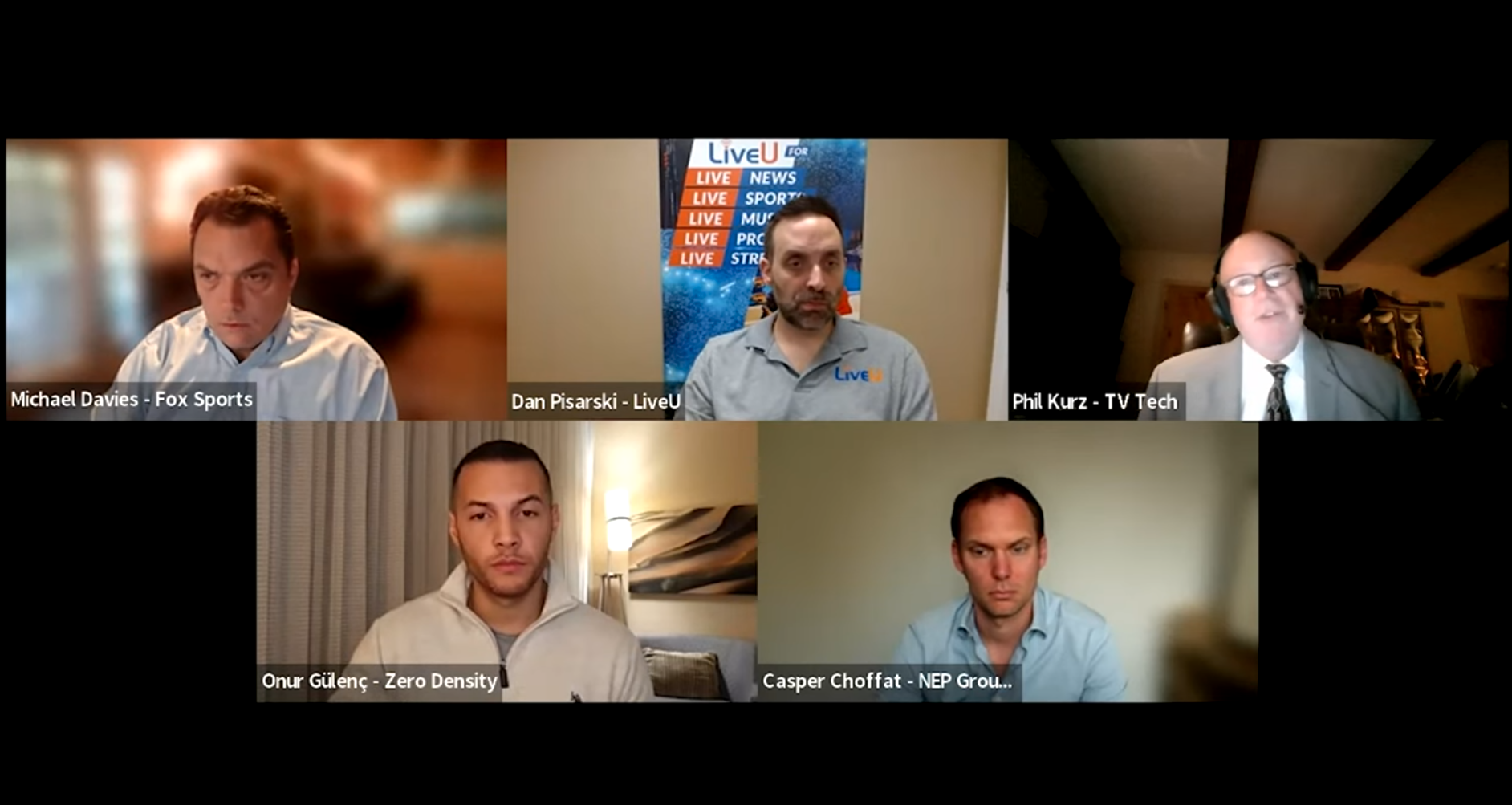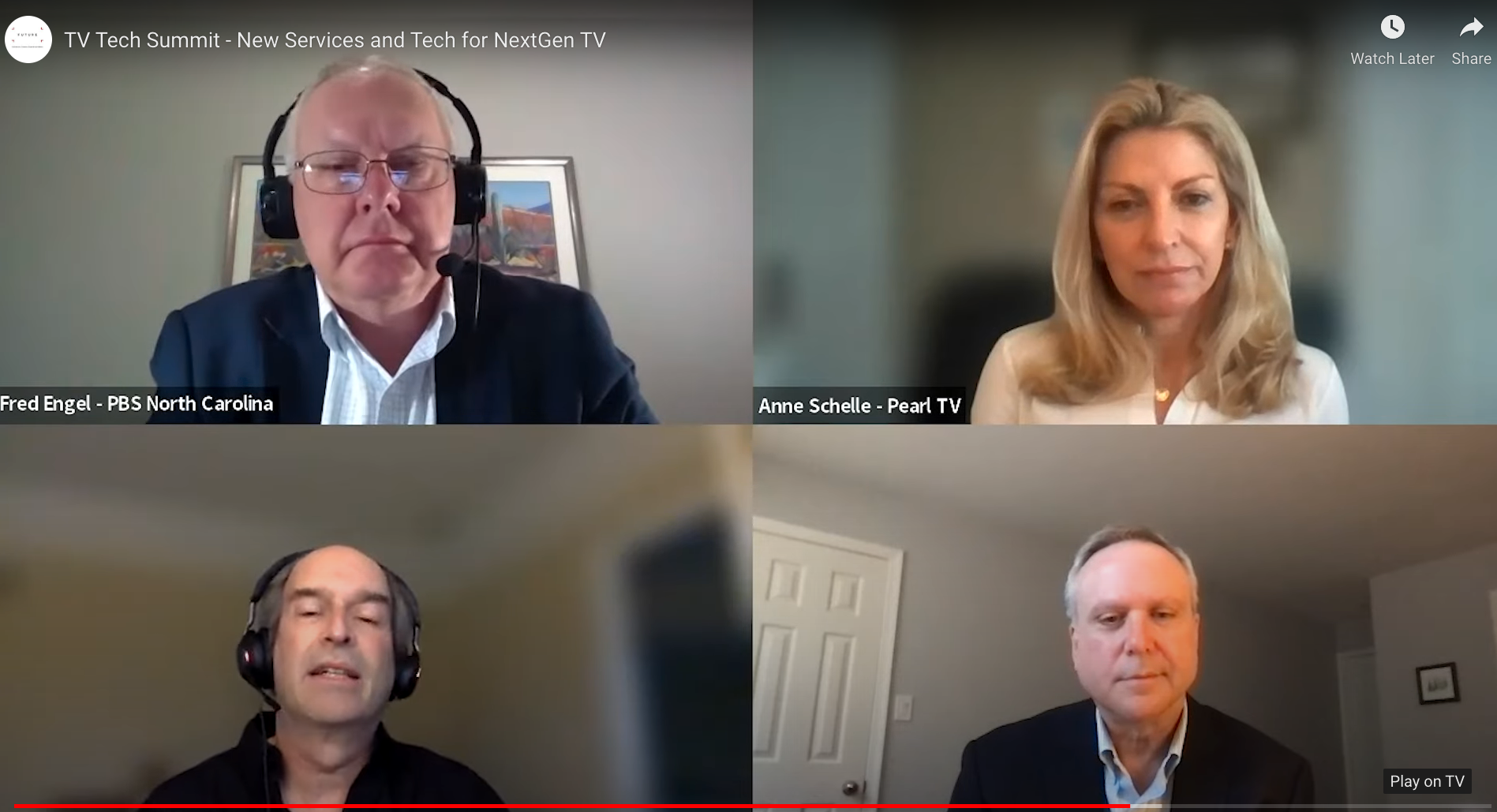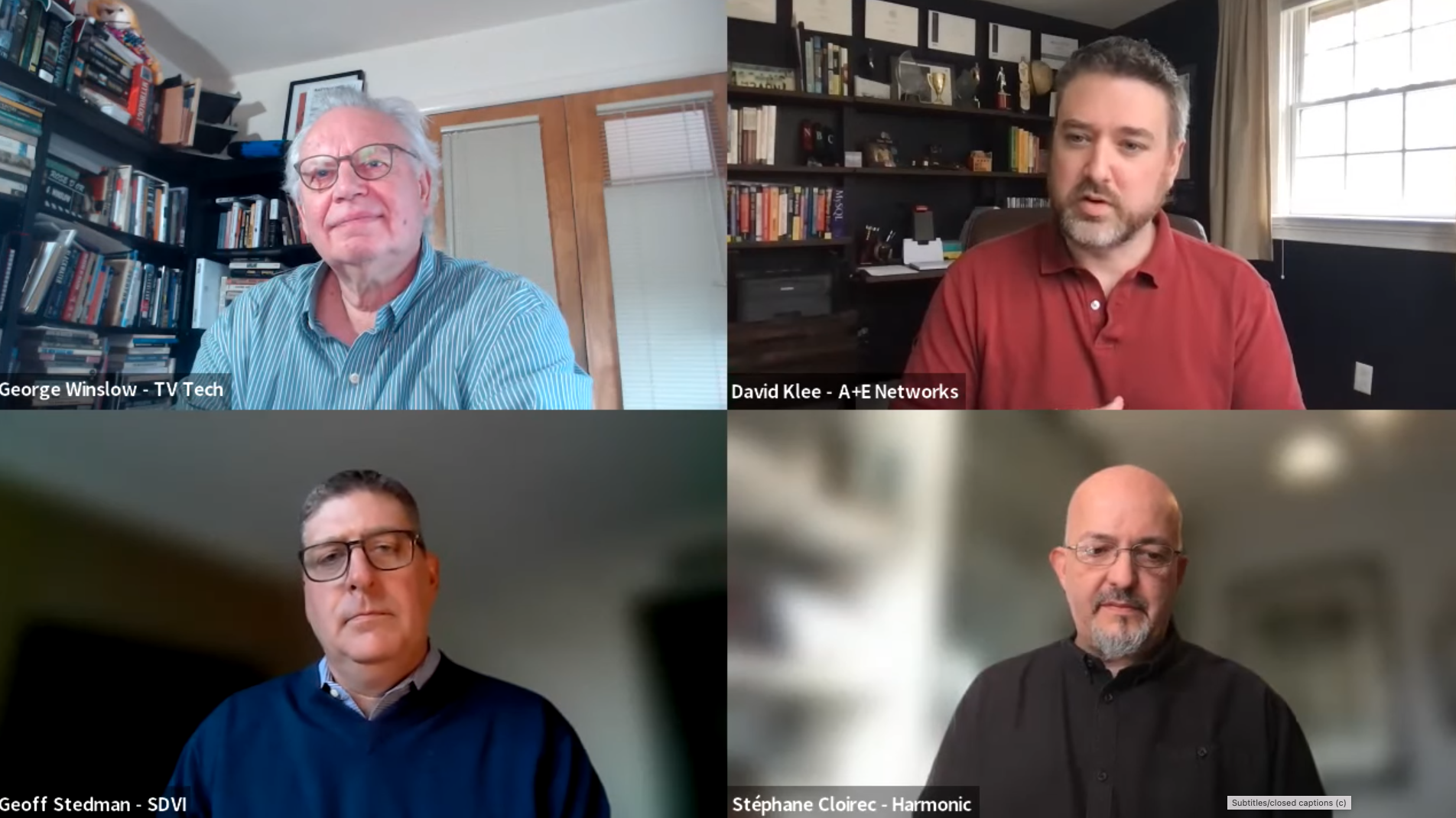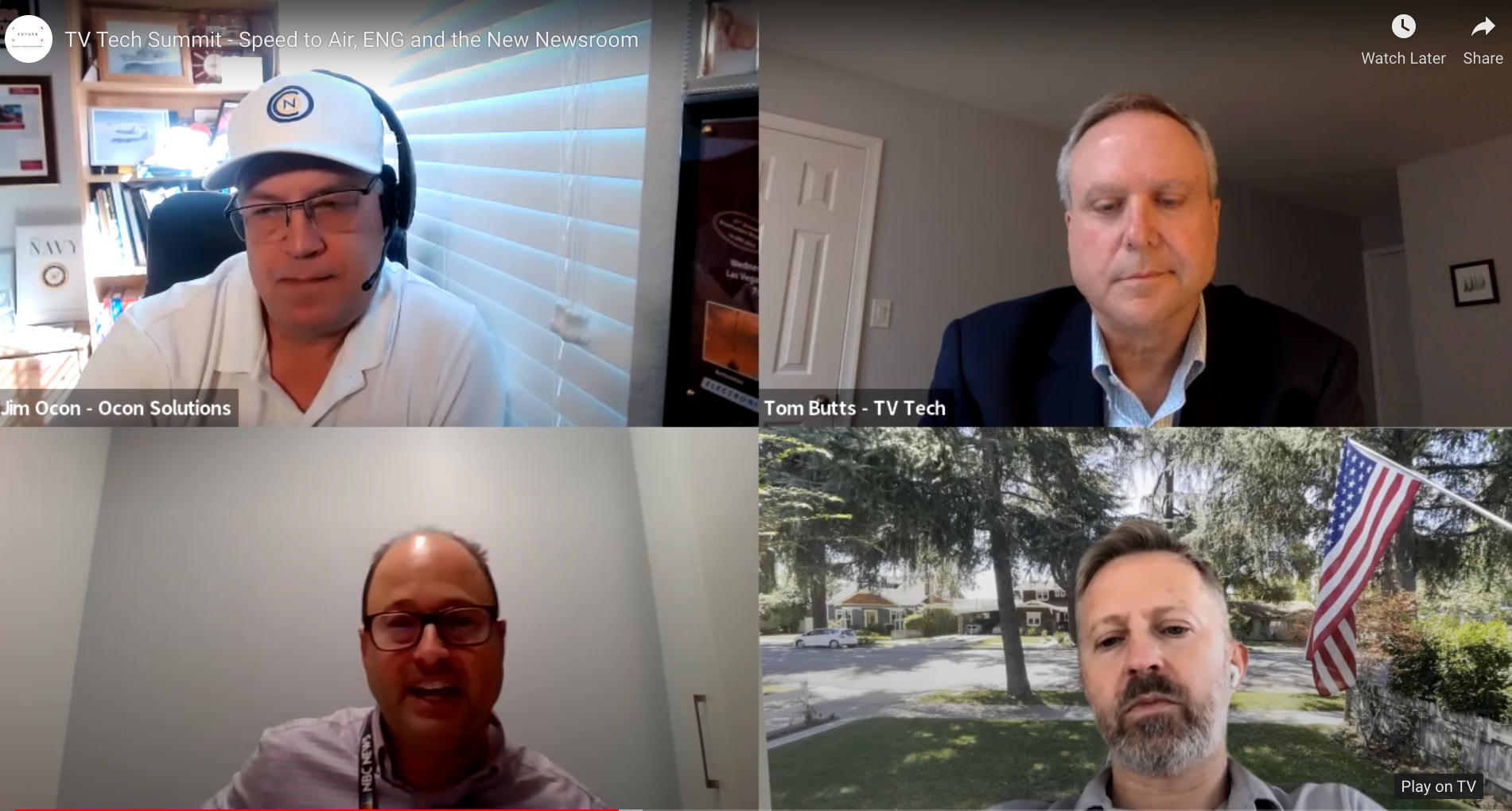
This week’s 2022 Spring TV Tech Summit provided an opportunity for our industry to discuss the current state of M&E tech as well as take a peek into trends that will shape the future of television. In a series of keynotes and panels, the lively discussions from industry experts covered a range of topics, from NextGen TV to AI, news production and the cloud, and how it is revolutionizing live and remote production.
Del Parks, President of Technology, Sinclair Broadcast Group
The summit started off with a keynote conversation with Del Parks, President of Technology for Sinclair Broadcasting Group. Parks, a long-time veteran broadcaster, talked about how the company is adapting and diversifying its content offerings and expanding its reach.

Ruminating on how the pandemic of the past two years has impacted Sinclair’s operations, Parks said the company was well-prepared.
“We were in a pretty good position, and ready to adapt,” he said. “COVID affected all of our communities and so viewers and customers were experiencing the same constraints and limitations as broadcasters were, so I don't think it was a big surprise when our viewers saw our meteorologists reporting from their homes or our reporters were using Skype or Zoom to interview newsmakers.
“I think the overall lesson it taught us is that innovation and adaptability can be embraced with reasonable solutions that can get the job done. And under these circumstances, I think our viewers have accepted it,” he added.
Adoption of the cloud for broadcast has been a major trend for a decade but that trend was accelerated due to the demands of ramping up remote production operations over the past two years. Sinclair was an early adopter of the cloud and has expanded its capabilities beyond just storage and distribution, Parks said.
“We began with the playout of a kids’ programming block from the public cloud in 2017,” he said. “Today we play out all of our diginet feeds from the public cloud and distribute to our affiliates using our LTN IP network. Additionally, in the last year, or so we've built a media content management, storage and distribution system that services our sports and broadcast users across the Sinclair family and that also operates out of the public cloud. Interestingly, enough, the pandemic accelerated the development and implementation of that.”
The professional video industry's #1 source for news, trends and product and tech information. Sign up below.
Security is top of mind among broadcasters and Parks talked about the cyber attack that hit Sinclair’s media operations last fall. “Our IT department and our broadcast engineers, everybody, worked together and we recovered from it pretty well and in the process, strengthened our systems,” he said.
Catherine Badalamente, President of Graham Media Group
Catherine Badalamente, the new president of Graham Media Group, and the second keynoter of the day, discussed the evolution of today’s TV station groups where broadcast is just one of a range of distribution platforms.
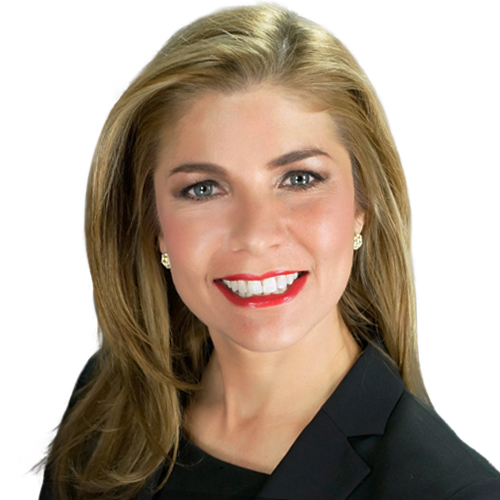
Badalamente, who previously headed up GMG’s digital operations, discussed the importance of a robust digital division. “We position ourselves as being at the forefront of the digital side, especially in broadcast,” she said. “We were one of the first groups to actually have OTT apps in the marketplace and we’ve really leaned heavily into streaming. We have also pushed hard on NextGen TV and have itin all of (six of) our markets.”
Badalemente said GMG learned a number of lessons over the past several years, and the experience with the pandemic reminded her of how broadcasters are driven by innovation to adapt and remain relevant to their viewers.
“There were a lot of things that were done that frankly, for years, people would have said were impossible. We were forced to create new ways of doing things and it was amazing how the station stepped up,” she said, referring to how stations ramped up their remote production capabilities in response to lockdowns.
“In terms of being able to create frictionless processes for people to work from home, we were able to look at new ways of delivering our message, new ways of communicating with our audience,” said, adding that the silver lining was that “there were things done within that first year of COVID that I think would have taken five years if we hadn't had a pandemic.”
Badalamente discussed how the decline of local newspapers has further illustrated the importance of local broadcasters in their community.
“I think that we are really in a unique position like we've never been before,” she said. “We take our position in our communities very seriously. Frankly, there's not a lot of competition coming from the newspaper side in our markets, unfortunately. And that means that we have to actually pick up the slack and make sure that we have that level of coverage so we can make sure that we are protecting our communities, making sure that we're being able to serve them the right way.”
Eric Hutto, President, Diversified
The final keynote of the summit was from Eric Hutto, the new president of Diversified, one of the world’s largest media technology and system integration companies.

Hutto comes to Diversified after serving in executive roles at tech giants such as Unisys, Dell and KPMG and TV Tech Senior Content Producer George Winslow asked him how his experiences prepared him for his new role heading up a large M&E tech and IT firm.
“Let's start with just where the world's going—it's all about an experience and creating energy, and providing services,” he said. “So this particular industry was already bouncing up against IT services. A lot of the ways that IPTV is going to evolve is going to be through cloud—and we’re going to have to have a really high level of security knowledge because it's just getting more complex and sophisticated.
“And really the intent of broadcasting is to communicate—to get information out and to let people create content and share,” he added. “So I think when I looked at this industry, it was intriguing to me because services are right in the midst of this conversation.”
Hutto also commented on the changing nature of systems integration, going from a hardware-intensive operation to more software-based systems and how Diversified has adapted to this trend by establishing a media workflow group, for example.
“One of the things I think that Diversified were already leaning into is workflows, and that's really what business is all about these days,” he said. “It's not so much about infrastructure and applications—it's about the workflows, and the things underneath it.”
Helping media companies integrate next-gen technologies such as AI, machine learning as well as augmented intelligence are also important trends to watch in M&E tech, Hutto said.
“Looking back, you've heard a lot about machine learning and artificial intelligence in the IT space, but over here (in media), it's augmented intelligence,” he said. “Companies just can't afford to raise all their staff to be able to do all the different things that they have, including traditional broadcasting and IPTV, for instance. So how do you use augmented intelligence to do a lot of things that people were doing so that they don't have to do anymore? I think that involves staff balancing and letting your expertise go to where it is.
“In terms of streaming, we all can do it,” he added. “But that's not why a company like Netflix is successful. It's their engine that allows them to generate content specific to me, that they're the curator of the content that makes them special.”
New Life for Live Production Tools
The panel “New Life for Live Production Tools” delved into new technologies and workflows that have allowed broadcasters and media enterprises to expand and improve live coverage.
Michael Davies, senior vice president of Fox Sports, discussed how the network created a new look for its NASCAR coverage when it broadcast the “The Busch Light Clash At The Coliseum” in February.
“It was a NASCAR race that was done in the LA Coliseum and that's never been done before. So we had no idea what that would really look like,” he said. NASCAR and Fox Sports worked from a rendering of the Coliseum as a race track, which gave the network a much better idea of what the race was going to look like in terms of camera placement, Davies added.
Zero Density, a provider of virtual studio, augmented reality and real-time graphics technologies has worked with Fox Sports on its NASCAR coverage and Onur Gülenç, territory manager for the company, explained how the use of VR, AR and xR tech is expanding in the media and broadcast space.
“We’ve worked with The Weather Channel’s 24/7 virtual weather presentation, MLB on Turner Sports and NEP is a partner as well,” Gülenç said.
Daniel Pisarski, VP of engineering for LiveU, discussed the role that bonded cellular companies have played in helping broadcasters adjust to the realities of keeping operations running smoothly during the pandemic.
“A lot has been said about how the pandemic took workflows that users were curious about, but accelerated things and forced the industry to adopt them—and part of that definitely is ground-to cloud—you're out there shooting this content and you need to get it back to a centralized control room,” he said. “And then during the pandemic, a lot of people tried it out. Our customers said ‘we need to get it back to a virtual control room in the cloud and have our team distribute and interact with the cloud from the locations we’re in,’ and bonded cellular makes a great fit for that.”
Casper Choffat, SVP, Global Product for NEP Group explained how the mobile production giant is adapting new centralized production methods to work with new remote production scenarios.
“All of our truck and flypack deployments will eventually have our NEP platform control system, which we are calling TOC,” Choffat said. “And that control system basically ensures that for the operator or for the clients, the experience inside of the control room remains the same if you step into an OB truck, or if you step into facility, or if you use a flypack, because eventually our vision is that everybody will use that control system when they use NEP capabilities.”
The Future of Cloud Technologies
In “The Future of Cloud Technologies,” panelists discussed the vital role of cloud technology in today’s broadcast media environment.
Kate Tempelmeyer, media services director for Nebraska Public Media, discussed how the network’s early adoption of cloud evolved into a hybrid setup.
‘We actually started working with Avid a number of years ago, when we virtualized our first stack of servers,” she said. “And as time went on we morphed into kind of a hybrid solution—living on premise and being able to edit in the Nexus cloud and it's proven to be a good solution for us.”
David Rosen, VP, Cloud Applications and Services for Sony, explained how the role of the cloud in media has changed.
“From an application standpoint, we're starting to see a migration away from the overall use of the cloud for distribution purposes,” he said. “In terms of content creation, getting the content that’s actually going to play out is now starting to move into the cloud as well. And I think there have been some pretty cool applications that we've been seeing from a live production standpoint, people actually starting to do switching of certain events. And I think we're going to start to see that begin to encroach upon some of the larger events as people become a bit more aware of what some of their limitations are.”
Karl Paulsen, CTO for Diversified, said for facilities transitioning to the cloud, a number of questions need to be asked.
“How much of the cloud do you use? Do you use more than one cloud? How do you move from one cloud to another? We've got the opportunities now to do a lot of thinking about where this is going, particularly in facilities that are still maybe a year or more away before the physical construction goes on,” he said.
John Footen, managing director, M&E for Deloitte Consulting predicted that the cloud will provide enormous capabilities in enhancing how viewers watch live events.
“When we reach a point where all of the cameras in a sporting event are in cloud and all of our customers are in the cloud, all the viewers are all meeting in one place—one ‘bucket’ of video that is in one place with the most incredible computing power ever brought to bear, in theory and in practice, we can then make different versions of the content for every viewer, he said. “We no longer have to have one version of the show. And the future implications of that are quite interesting.”
New Services and Tech for NextGen TV
During the “New Services and Tech for NextGen TV,” Anne Schelle, managing director for Pearl TV provided a progress report on where the transition to ATSC 3.0 currently stands.
“We ended 2021 in a great place with over 40 markets launched, representing over 45% of U.S. households, this is during a two year pandemic, so I give the broadcasters a lot of credit for launching and being able to keep up, even when sometimes they couldn't get into TV stations,” she said. “The other piece of this is TV manufacturers; they put out over 70 models last year from Samsung, LG and Sony. Sony has incorporated NextGen TV technology in every single one of its models—the lowest priced television out there during the holiday season was around $544. The CTA announced that over three and a half million TV sets were sold already. And that's just starting out with those three manufacturers.”
Fred Engel, CTO for PBS North Carolina, discussed the networks’ work on facilitating ATSC 3.0 technology with first responders. The network received a grant from the NAB PILOT Innovation Challenge in 2017 to develop the system, partnering with Capitol Broadcasting Company in Raleigh.
“In 2018 we did the first testing where we routed 911 dispatch information over an ATSC 3.0 transmitter and captured it on a computer,” he said. “In 2019 we launched our ATSC 3.0 lab that includes all the encoding, all the processing gear that you need to have for that. We have a Ch. 20 TV exciter operational, so we can look at all the receiving devices and do a lot of testing on public safety and other efforts that we're working on.”
On the audio side, John Schur, president of the Solutions Group for Telos Alliance, discussed the important role of immersive and personalized audio in the ATSC 3.0 environment.
“For many years we've helped broadcasters develop their workflows around ATSC 1.0,” he said. “ATSC 3.0 has so many new and exciting features when it comes to audio, and it's really designed to enhance the listeners’ experience for both the video and audio. One of those is immersive audio—more channels, more speakers. But to me the exciting thing is that with the new codecs like Dolby AC, they can create a presentation that's rendered for the listener’s environment. There’s also dialogue enhancement which is another feature that's built into the codec so the broadcaster doesn't have to do anything special to take advantage of it.”
Streamlined Content Delivery to Multiple Platforms
During the “Streamlined Content Delivery to Multiple Platforms,” panelists discussed how media companies are managing the myriad services that come with the explosion in OTT.
“It’s no surprise to anyone in the two years of COVID that it's really been a game changer in all the aspects of the video chain,” said Stéphane Cloirec, Vice President, Video Appliance Product Management for Harmonic. “We have seen on the user side, the explosion of streaming adoption, but also for all the professional video professional companies that have been forced to work from home. And one main consequence we have seen out of those changes is that cloud adoption as a result has been accelerating at a pace that was never seen before. It has really been a key driver.”
Geoff Stedman, CMO for SDVI, discussed the challenge of creating efficiency in a media supply chain.
“What I think of efficiency, it’s this idea of being able to get more done with the same or even fewer resources,” he said. “We hear a lot about the pressure that companies are under to support the changes that are happening with their business and not necessarily getting more resources in order to deal with that. So this drive to make my operations more efficient is absolutely a big challenge that we hear customers facing. On the other hand, another big challenge is what I call ‘responsiveness’ or being able to adapt quickly to changes in the business needs.”
David Klee, VP Strategic Media Solutions for A&E Networks, noted that unlike its counterparts, it has not launched a “plus” version of its library.
“A&E’s focused on delivering content to many of those [plus] platforms to enable them to supplement their libraries, provide additional content and value to their subscribers as they're launching these new platforms,” he said. “So we have to be very good at multiplatform delivery. With the ‘acronym soup’ that is today's AVOD, SVOD, FAST, MVPD world, we make sure that we're able to get each of those partners, the media metadata that they need in a timely basis to support not only the ongoing crunch of daily content flows, but also new launches and new deals and new opportunities in the marketplace.”
Speed to Air, ENG and the New Newsroom
In the final panel of the day, “Speed to Air, ENG and the New Newsroom,” panelists showcased the rapid changes taking place in news acquisition and delivery. In addition to the cloud, panelists discussed the changing role of satellites in ENG operations.
“I have been talking more about satellites this last week than I have done in the last 10 years,” said Jon Landman, VP of sales for Teradek. “These new satellites are basically a million dollars to launch—not $100 million—and eventually it will come down to a news organization owning their own satellite network.”
Landman added that these low earth satellites will reinvigorate satellite’s place in the broadcast news landscape.
“I think that we have to look at that as the future for connectivity because they're really bringing them down to a cost that organizations will love,” he said.
Jeffrey Liebman, Director, Network News Operations for Telemundo-NBC noted that there are still certain challenges that go with incorporating satellites for news coverage.
“With K-band we found that it works great if you're in, let's say, Texas or the center of the United States, but it really doesn't work well on the periphery in Mexico,” he said. “And that becomes my concern—if we do launch these low earth orbiting satellites, one of the things that we're always going to be dealing with or grappling with is, are they in the right position in the right place?”
Jim Ocon, president of Ocon Solutions & Chairman, OConsortium, summed up the panel discussion with some thoughts about how the technology is secondary to its overall application.
“If you look at the products that are out there, and how robotics are now incorporating artificial intelligence and smart resourcing and sim connections, ENG is about technology, but technology is always changing. And so we always have to be looking at where that sun rises and what's going to help our folks in the field. The last year and a half with COVID has just amplified things, but for me the technology isn't the sticking point. It's the application.”
Sponsors of the summit include:
- Platinum: Harmonic
- Gold: LiveU, SDVI, Sony, Telos Alliance, Teradek & Zero Density
The TV Tech Summit is available on demand at tvtechsummit/march.
Tom has covered the broadcast technology market for the past 25 years, including three years handling member communications for the National Association of Broadcasters followed by a year as editor of Video Technology News and DTV Business executive newsletters for Phillips Publishing. In 1999 he launched digitalbroadcasting.com for internet B2B portal Verticalnet. He is also a charter member of the CTA's Academy of Digital TV Pioneers. Since 2001, he has been editor-in-chief of TV Tech (www.tvtech.com), the leading source of news and information on broadcast and related media technology and is a frequent contributor and moderator to the brand’s Tech Leadership events.
